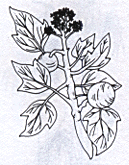Canoe Plants of Ancient Hawai`i Home - Intro - Contents - Bibliography - Links - Credits `Ape - `Awa -`Awapuhi -Hau -Ipu -Kalo -Kamani -Ki -Ko -Kou -Kukui -Mai`a Milo -Niu -Noni -`Ohe -`Ohi`a `Ai -`Olena -Olona -Pia -`Uala -Uhi -`Ulu -Wauke |
Canoe Plants of Ancient Hawai`i Home - Intro - Contents - Bibliography - Links - Credits `Ape - `Awa -`Awapuhi -Hau -Ipu -Kalo -Kamani -Ki -Ko -Kou -Kukui -Mai`a Milo -Niu -Noni -`Ohe -`Ohi`a `Ai -`Olena -Olona -Pia -`Uala -Uhi -`Ulu -Wauke |
 When I first rode to Hana years ago, I noticed the kukui trees, distinctive in their pale green silvery foliage, growing on the slopes of the mountain. Over the years, I have come to love these ancestors that thrive here in Hawai`i Nei, some so large as 50 feet. The tree is a symbol of enlightenment, protection and peace. Kukui was considered to be the body form of Kamapua'a, the pig god. On the altar of Lono was placed a wooden carving shaped like a pig's head.
When I first rode to Hana years ago, I noticed the kukui trees, distinctive in their pale green silvery foliage, growing on the slopes of the mountain. Over the years, I have come to love these ancestors that thrive here in Hawai`i Nei, some so large as 50 feet. The tree is a symbol of enlightenment, protection and peace. Kukui was considered to be the body form of Kamapua'a, the pig god. On the altar of Lono was placed a wooden carving shaped like a pig's head.The seeds of this plant were brought to Hawai`i by the first Polynesian voyagers. Today this member of the Spurge family commonly grows wild in the lower mountain forest areas and is planted in gardens as a shade tree, although it is a bit messy due to dropping its leaves and nuts, up to 100 pounds per tree. Its scientific name is Aleurites moluccana.
The kukui nut has many uses. Originally it was most valued for its light, the oil of the white kernels being extracted for its use in stone lamps and in ti leaf sheath torches. The shelled nuts were skewered on a coconut frond mid-rib and lit one by one, from the top to bottom, as they sat in a container of sand or dirt, or in the earth itself. Often children were given the responsibility for keeping the "candles" lit. The tree is sometimes called the Candlenut Tree. The nuts are widely used as a traditional lei, both the hard shells of the polished black, tan or brown, and immature white, which are more rare. The white flowers and downy, angularly pointed leaves are also strung as lei, representing Moloka`i, whose symbolic color is silvery green. The bark, flowers and nuts are all used for medicine. As food, a small amount of the pounded roasted nuts, plus salt and sometimes chili peppers, is used as a relish and is called `inamona.
The small, five-petaled white flowers were chewed by the parents of a young child and given to the child to aid in healing of e`a (thrush) sores inside the mouth and upon the tongue. Also used for this problem was the juicy sap that fills up the depression left when the stem is pulled off the green fruit. This is applied with the finger and rubbed inside of the child's mouth and on the tongue. The green fruit is the part of the plant that contains the nut. This sap is also a healing application for chapped lips, cold sores and mild sunburn.
One mashed nut (sometimes the raw kernel, sometimes the roasted) or the sap of the green nut was often used in combination with other traditional Hawai`i medicinal plants, particularly when a purgative for constipation was needed. The potency of this plant is so strong that these internal remedies are administered very carefully by those with experience in these matters. The late Uncle Harry Mitchell of Keanae recommended the use of kukui nut for high blood pressure. He suggested one teaspoon a day of the ground roasted kernel. Sometimes this is mixed with pressed garlic juice.
For bad cases of ulcers and other skin sores, the baked meat of ripe kukui nuts was pounded and mixed with other plants, such as ripe noni fruit. In the treatment of rheumatic joints or deep bruises and wounds, kukui and noni leaves were wrapped around the afflicted places and heat applied by hot packs of salt, sand or rocks wrapped in tapa cloth.
The inner bark provided a red-brown dye for tapa cloth and `olona cordage, while the gum from the bark strengthened the tapa. The soot (pau) of burned nuts provided a black dye for tattooing and for painting designs on canoes and on tapa cloth. The soft light-colored wood of the tree trunk was fashioned into canoes. The oil provided a varnish similar to linseed oil.
| Pupuhi kukui—malino ke kai. Spewed kukui nuts—calm sea. To calm the water, fishermen chewed kukui nuts and spewed them. It has the same meaning as, "Pour oil on troubled waters." |
The kukui tree is a classic example of the wisdom of ancient voyaging Polynesians. The plants that they chose to bring on their canoes had to serve many useful purposes. The kukui is such a plant.
![]()
| Canoe Plants of Ancient Hawai`i Home Intro - Contents - Bibliography - Links - Credits `Ape -`Awa -`Awapuhi -Hau -Ipu -Kalo -Kamani -Ki -Ko -Kou -Kukui - Mai`a |